The destruction of Dresden, 1945 year
Even after the end of the war for more than 60 years, there are calls in Europe to recognize the destruction of the ancient city of Dresden as a war crime and genocide against its inhabitants. Many in Europe and the United States hold the opinion that the bombardment of German cities in the final months of the war was no longer dictated by military necessity and was unnecessarily militarily. To recognize the bombardment of Dresden as a war crime, the Nobel Prize in Literature, the German writer Günther Grass, and the former editor of the English newspaper The Times, Simon Jenkins, are now demanding. They are supported by both the American journalist and literary critic Christopher Hitchens, who believes that the bombing of the last months of the war was carried out only with the aim of practicing the methods of bombing by young pilots.
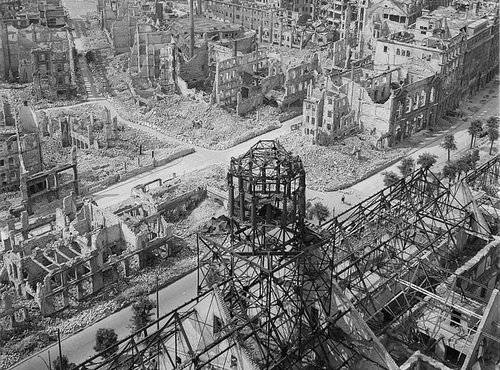
The number of victims of the bombing that the city underwent from 13 to 15 February 1945 of the year is estimated at 25 000 - 30 000 people, while many of the estimates have stepped over the mark at 100 000. During the bombing, the city was almost completely destroyed. The area of the zone of continuous destruction in the city in 4 times exceeded the area of the zone of complete destruction in Nagasaki. After the end of the war, the ruins of churches, palaces and residential buildings were dismantled and taken out of the city; only a site with marked borders of streets and buildings that remained here remained on the site of Dresden. The rebuilding of the city center took 40 years, the rest of the parts were restored earlier. At the same time, a number of historical buildings of the city located on the Neumarkt square are being restored.
Bombing
Before World War II, Dresden was recognized as one of the most beautiful cities in Europe. Many tourist guides called him Florence on the Elbe. There were a lot of objects of great cultural significance: the famous Dresden Gallery, the second largest porcelain museum in the world, the opera house, which competed in acoustics with the Teatro alla Scala, the palace ensemble Zwinger, many baroque-built churches. By the end of the war, a large number of refugees had flowed into the city. Many residents were confident that the city would not be bombed. There were no large military factories. In Germany, it was rumored that after the war, it was Dresden that could become the new capital.
For all the war, the Allies bombed the city only twice, not taking it as a military target. Bombs fell on the city of October 7 1944, when about 30 "Flying Fortress" B-17, which could not bomb the main target, hit Dresden, the former spare flight target. As well as January 16 1945, when the sorting railway station was bombed by 133 "Liberator".
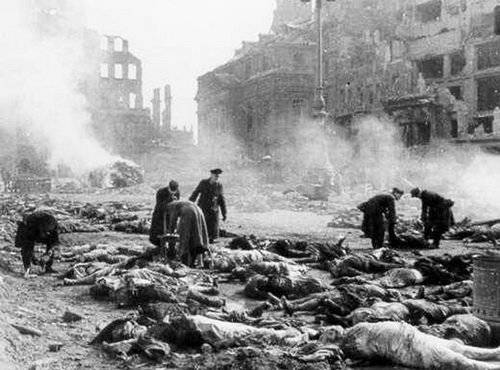
The air defense of the city was rather weak, the air-raid signal was given just a few minutes before the bombing began. Yes, and bombing in the city was nothing special. It housed 2 large tobacco factories, which produced a significant part of the German tobacco products, soap factory and a number of breweries. There was a factory of the firm "Siemens" for the production of gas masks, an enterprise of the firm "Zeiss", specializing in optics and several small enterprises for the production of radio electronics for the needs of the aviation industry. At the same time, they were all located on the outskirts of the city, while the historical center was subjected to bombardment.
Before the war in Dresden, there were about 650 000 residents, by February at least 200 000 refugees had arrived, their exact number could not be counted. By 1945, the British and Americans were already great specialists in the destruction of German cities. They developed special techniques that increased the effectiveness of the bombing. The first wave of bombers dropped high-explosive bombs, which were to destroy the roofs of houses, knock out windows, expose wooden structures, followed by a second wave of bombers dropping incendiary bombs on the city. After that, high-explosive bombs were again dropped on the city, which were supposed to complicate the work of fire and rescue services.
At around 22 in the evening of February 13, residents of the outskirts of Dresden heard the roar of approaching aircraft. In 22 hours of the 13 minutes, the first bombs were dropped on the city, the city was bombed by the first wave of British heavy bombers - the 244 Lancaster. In a matter of minutes, the entire city was engulfed in flames, which was visible at a distance of more than 150 km. The main blow to the city was struck between 1: 23 and 1: 53 at night, when the city bombed 515 British heavy bombers. After hitting the first wave, nothing prevented the spread of fires in the city, the high-explosive bombs of the second wave only contributed to the expansion of the area engulfed in fire, and prevented the fire brigades. A total of about 13 14 tons of high-explosive and 1 500 tons of incendiary bombs were dropped on the city from 1 on 200 in February on the night of February. The total number of incendiary bombs dropped on the city was 650 000 units.
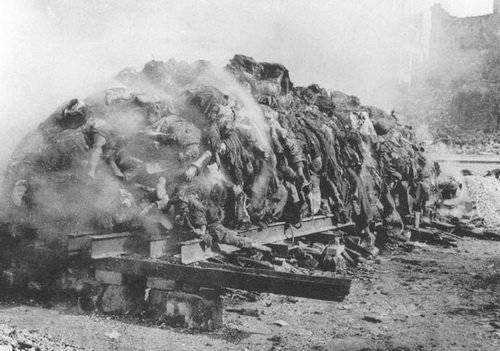
And it was not the last air strike. In the morning, the X-NUMX of the American B-311 bombers took off, accompanied by the X-NUMX fighter P-17 Mustang, divided into 72 groups. One of them was constantly covering the bombers, and the second after the bombing, was supposed to begin to attack the targets of the pilots. Bombs rained down on the city in 51: 2, the bombing lasted 12 minutes, during which time about 12 tons of high-explosive and 11 tons of incendiary bombs were dropped on the city. After that, a group of 500 fighters "Mustang" began to attack the roads leading from the city, which were filled with refugees and civilians. The next day, the city again bombed 300 American bombers, dropping tons of high-explosive bombs to the city 37.
One of the pilots of the Royal Air Force, who participated in the raid, recalled: “The fantastically bright light became brighter, the closer we approached the target, at an altitude of about 6 000 meters, it was possible to distinguish parts of the terrain that had never been seen before; For the first time ever, I felt sorry for the residents who were downstairs. ” Another participant in the bombardment of the navigator-scorer noted: “When I looked down, I saw a wide panorama of the city, which was burning from one side to the other, it was visible thick smoke, which carried to the side. My first reaction was the thought of the coincidence of the carnage that took place below with the evangelical sermons that I heard before the war. ”
As a result of the bombing of Dresden, it was planned to create a fiery tornado on its streets and these plans came true. This tornado occurs when scattered fires unite into one fantastic bonfire. The air above it warms up, its density decreases, and it rises up. The temperature in the fire tornado that engulfed the city reached 1500 degrees.
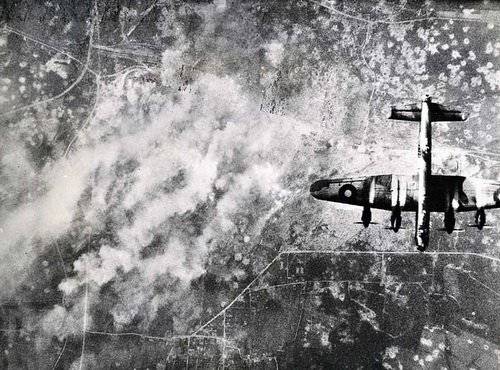
A historian from England, David Irving, described the firestorm in Dresden as follows. The fire tornado that formed as a result of the bombardment, on the basis of surveys, absorbed more than 75% of the entire territory of destruction in the city. His strength allowed him to rip out giant trees with roots, crowds trying to flee people were picked up by these tornadoes and thrown straight into the fire. The torn roofs of buildings and furniture were thrown into the center of the burning historical part of the city. The tornado reached its peak in the three-hour gap between the airstrikes, at the moment when the inhabitants of the city, who had taken refuge in the basements and shelters, were trying to escape to its outskirts. On the streets of Dresden, asphalt melted, and people falling into it, merged with the road surface.
The railway worker, who was hiding near Pochtovaya Square, saw a woman with a baby carriage dragged along the street and thrown into the flames. Other residents of the city, who were trying to flee along the railway embankment, which was not filled up with debris, saw railway cars on open sections of the roads simply blew off with a storm.
According to the report of the Dresden police, which was drawn up after the raids, 12 thousands of buildings burned down in the city. It was destroyed 3 Theater, 5 consulates, 11 churches, 60 chapels, 19 hospitals and 19 post offices, 50 cultural and historic buildings, 24 Bank, 26 insurance companies, 26 brothels, 31 hotel, 31 trading shop, 39 schools, 63 administrative buildings , 256 trading floors, 640 warehouses, 6470 stores. In addition, the fire destroyed the zoo, waterworks, railway depot, 4 tram depot, 19 ships and barges on the Elbe.
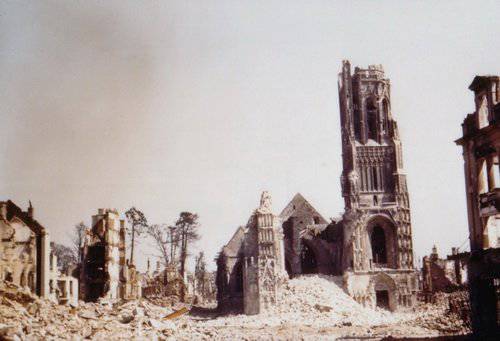
What was it for?
Formally, the Allies had reason to bomb the city. The United States and Britain agreed with the USSR on the bombing of Berlin and Leipzig; there was no talk of Dresden. But this large 7-th largest city in Germany really was a major transportation center. And the Allies declared that they bombed the city with the goal of making it impossible to move traffic around these cities. According to the American side, the bombing of Berlin, Leipzig and Dresden was important and contributed to the withdrawal of these transport hubs. Indirectly, the effectiveness of the bombing was confirmed by the fact that, near Leipzig, in Torgau, on April 25, the advance units of the allied forces met, cutting Germany into two.
However, even the memorandum, which was read out to British pilots before the February 13 bombing mission, revealed the true meaning of this military operation: Dresden, 7 is the largest city in Germany ... currently, the largest enemy area is still not bombed. In the middle of winter, with refugees heading west and troops to be stationed somewhere, living quarters are in short supply, since it requires not only accommodating workers, refugees and troops, but also government agencies evacuated from other areas. At one time Dresden, widely known for its porcelain manufacturing, developed into a large industrial center ... The aim of the attack is to strike the enemy where he feels it most strongly, behind the partially collapsed front ... and at the same time show the Russians when they arrive in the city. Royal Air Force.
In February, 1945, Germany was already on the verge of a catastrophe, which could not be delayed. The task of defeating Germany was completely solved, the Western allies of the USSR looked to the future, concerned about their post-war relations with Moscow.
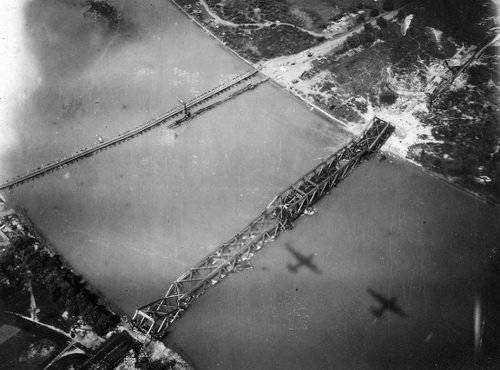
Before the Second World War, the USSR, according to modern terminology, was still considered an outcast country. The USSR was not invited to Munich, where the fate of Czechoslovakia and, as it turned out later, the whole of Europe was decided. Not invited to the London and Washington conferences. At that time, Italy was recognized as a great power, but the USSR - not. However, by 1945, few doubted the power of the Soviet Union. And although the USSR did not have a strong sea fleet and did not have strategic aviation, in its offensive capabilities tank armies no one doubted. They were quite capable of reaching the English Channel, and hardly anyone could stop them.
The flames from the fire in Dresden were visible at a distance of 200 km. from the city on the Soviet front. More than half of residential buildings were destroyed in the city, a lot of architectural monuments, while the large sorting stations did not receive serious damage, one of the Elbe railway bridges was intact, and a military airfield in the vicinity of the city also received no damage. Great Britain and the United States needed to show their power, make an impression on Stalin, which is why the city practically unaffected by the bombing was chosen to demonstrate. For the Anglo-American strategists, the lives of its inhabitants became just a bargaining chip in their political game.
Alexey Denisov's film is dedicated to the events of February 13, 1945 - the bombing of Dresden by the Anglo-American aviation During the Second World War. This action was interpreted by the Allies as an act of assistance to Soviet troops advancing from the east, allegedly in support of the Yalta agreements.
The implementation of the barbaric bombardment took place in three calls by forces of almost three thousand aircraft. Her result - the death of more than 135 thousands of people and the destruction of 35 near 470 buildings.
One of the main questions that the filmmakers tried to answer was whether there was such a request from the Soviet side and why, to this day, former allies from England and America are trying hard to shift the blame for the senseless bombardment of one of the most beautiful cities in Europe, besides military value, on Russia.
German and Russian historians, American pilots and eyewitnesses of this tragedy take part in the film.
Information